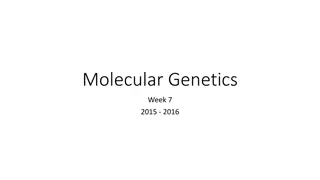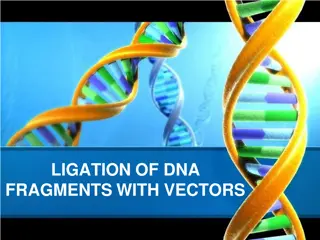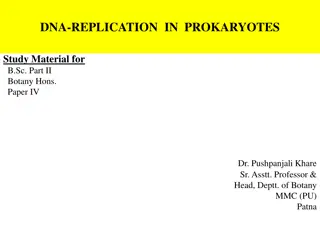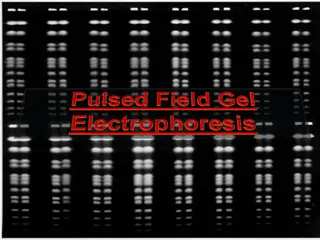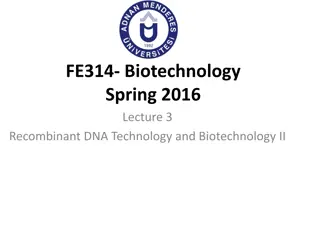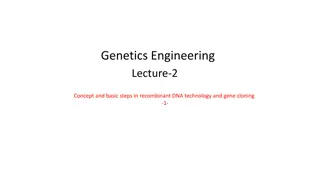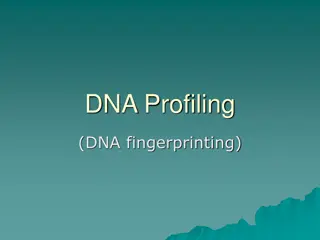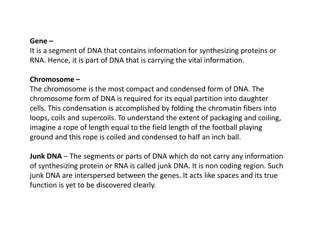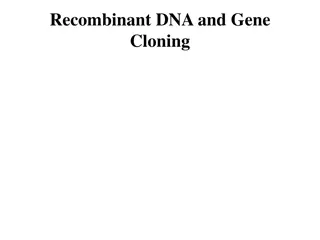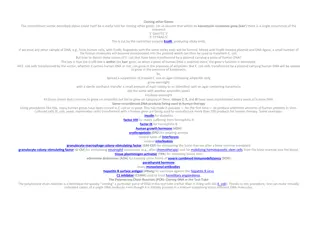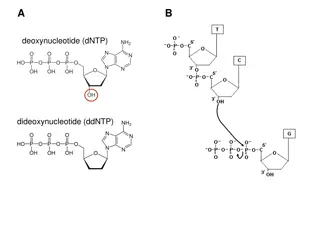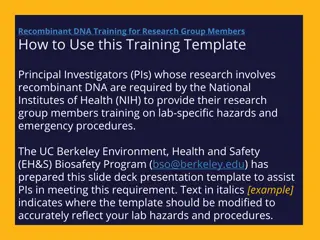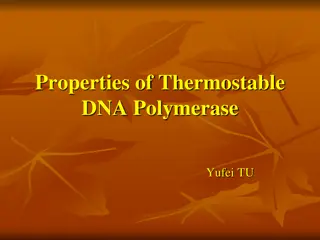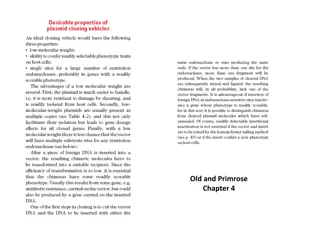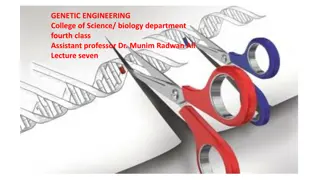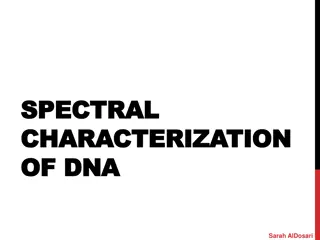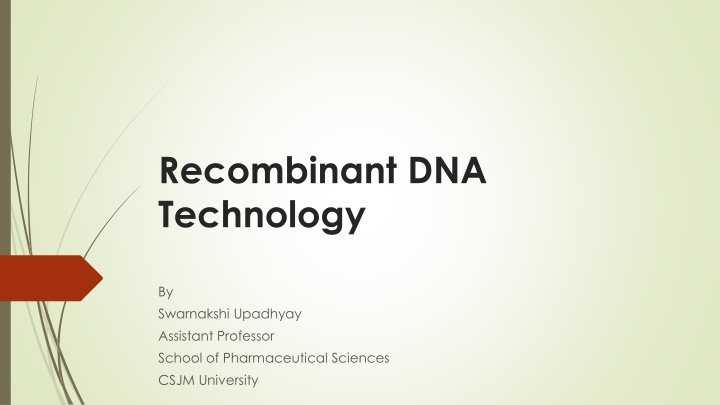
Recombinant DNA Technology for Genetic Engineering
Explore the steps involved in recombinant DNA technology, from isolating genetic material to inserting recombinant DNA into host organisms. Learn how this technology revolutionized science, medicine, agriculture, and industry.
Download Presentation

Please find below an Image/Link to download the presentation.
The content on the website is provided AS IS for your information and personal use only. It may not be sold, licensed, or shared on other websites without obtaining consent from the author. If you encounter any issues during the download, it is possible that the publisher has removed the file from their server.
You are allowed to download the files provided on this website for personal or commercial use, subject to the condition that they are used lawfully. All files are the property of their respective owners.
The content on the website is provided AS IS for your information and personal use only. It may not be sold, licensed, or shared on other websites without obtaining consent from the author.
E N D
Presentation Transcript
Recombinant DNA Technology By Swarnakshi Upadhyay Assistant Professor School of Pharmaceutical Sciences CSJM University
INTRODUCTION Recombinant DNA technology refers to the joining together of DNA molecules from two different species that are inserted into a host organism to produce new genetic combinations that are of value to science, medicine, agriculture, and industry. Recombinant DNA (rDNA), on the other hand is the general name for a piece of DNA that has been created by the combination of at least two strands. They are DNA molecules formed by laboratory methods of genetic recombination (such as molecular cloning) to bring together genetic material from multiple sources, creating sequences that would not otherwise be found in the genome. Recombinant DNA in a living organism was first achieved in 1973 by Herbert Boyer, of the University of California at San Francisco, and Stanley Cohen, at Stanford University, who used E. coli restriction enzymes to insert foreign DNA into plasmids.
STEPS OF GENETIC RECOMBINATION TECHNOLOGY Isolation of Genetic Material Restriction Enzyme Digestion Amplification Using PCR Ligation of DNA Molecules Insertion of Recombinant DNA Into Host Isolation of Recombinant Cells
1. Isolation of Genetic Material The first step in rDNA technology is to isolate the desired DNA in its pure form i.e. free from other macromolecules. Since DNA exists within the cell membrane along with other macromolecules such as RNA, polysaccharides, proteins, and lipids, it must be separated and purified which involves enzymes such as lysozymes, cellulase, chitinase, ribonuclease, proteases etc. Other macromolecules are removable with other enzymes or treatments. Ultimately, the addition of ethanol causes the DNA to precipitate out as fine threads. This is then spooled out to give purified DNA.
2. Restriction Enzyme Digestion Restriction enzymes act as molecular scissors that cut DNA at specific locations. These reactions are called restriction enzyme digestions . They involve the incubation of the purified DNA with the selected restriction enzyme, at conditions optimal for that specific enzyme. The technique Agarose Gel Electrophoresis reveals the progress of the restriction enzyme digestion. This technique involves running out the DNA on an agarose gel. On the application of current, the negatively charged DNA travels to the positive electrode and is separated out based on size. This allows separating and cutting out the digested DNA fragments. The vector DNA is also processed using the same procedure.
3. Amplification Using PCR Polymerase Chain Reaction or PCR is a method of making multiple copies of a DNA sequence using the enzyme DNA polymerase in vitro. It helps to amplify a single copy or a few copies of DNA into thousands to millions of copies. PCR reactions are run on thermal cyclers using the following components: 1. Template DNA to be amplified 2. Primers small, chemically synthesized oligonucleotides that are complementary to a region of the DNA. 3. Enzyme DNA polymerase 4. Nucleotides needed to extend the primers by the enzyme. The cut fragments of DNA can be amplified using PCR and then ligated with the cut vector.
4. Ligation of DNA Molecules The purified DNA and the vector of interest are cut with the same restriction enzyme. This gives us the cut fragment of DNA and the cut vector, that is now open. The process of joining these two pieces together using the enzyme DNA ligase is ligation . The resulting DNA molecule is a hybrid of two DNA molecules the interest molecule and the vector. In the terminology of genetics this intermixing of different DNA strands is called recombination. Hence, this new hybrid DNA molecule is also called a recombinant DNA molecule and the technology is referred to as the recombinant DNA technology.
5. Insertion of Recombinant DNA Into Host In this step, the recombinant DNA is introduced into a recipient host cell mostly, a bacterial cell. This process is Transformation . Bacterial cells do not accept foreign DNA easily. Therefore, they are treated to make them competent to accept new DNA. The processes used may be thermal shock, Ca++ion treatment, electroporation etc.
6. Isolation of Recombinant Cells The transformation process generates a mixed population of transformed and non-trans- formed host cells. The selection process involves filtering the transformed host cells only. For isolation of recombinant cell from non-recombinant cell, marker gene of plasmid vector is employed. For examples, PBR322 plasmid vector contains different marker gene (Ampicillin resistant gene and Tetracycline resistant gene. When pst1 RE is used it knock out Ampicillin resistant gene from the plasmid, so that the recombinant cell become sensitive to Ampicillin.
APPLICATION OF RECOMBINANT DNA TECHNOLOGY Recombinant DNA is widely used in biotechnology, medicine and research. The most common application of recombinant DNA is in basic research, in which the technology is important to most current work in the biological and biomedical sciences. Recombinant DNA is used to identify, map and sequence genes, and to determine their function. Recombinant proteins are widely used as reagents in laboratory experiments and to generate antibody probes for examining protein synthesis within cells and organisms. Many additional practical applications of recombinant DNA are found in industry, food production, human and veterinary medicine, agriculture, and bioengineering. DNA technology is also used to detect the presence of HIV in a person. Application of recombinant DNA technology in Agriculture For example, manufacture of Bt-Cotton to protect the plant against ball worms. Application of medicines Insulin production by DNA recombinant technology is a classic example. Gene Therapy It is used as an attempt to correct the gene defects which give rise to heredity diseases. Clinical diagnosis ELISA is an example where the application of recombinant DNA is possible. 1. 2. 3. 4. 5.


